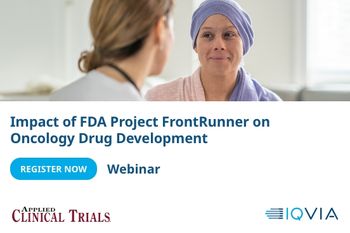
Applied Clinical Trials Supplements
- Supplements-10-02-2004
- Volume 0
- Issue 0
The Thorough Phase I ECG
The rapid emergence and global acceptance of new regulatory guidance has thrust cardiac safety to the forefront of new drug development during recent years. This is because the cardiac safety effects of new drugs is the most common cause of drug withdrawal from the market, or delays and a lack of regulatory approval for marketing. The resulting ECG Global Regulatory Imperative creates issues and offers opportunities for new drug developers striving for Best Practices in this important area.
The rapid emergence and global acceptance of new regulatory guidance has thrust cardiac safety to the forefront of new drug development during recent years. This is because the cardiac safety effects of new drugs is the most common cause of drug withdrawal from the market, or delays and a lack of regulatory approval for marketing. The resulting ECG Global Regulatory Imperative creates issues and offers opportunities for new drug developers striving for Best Practices in this important area.
Among the most significant practical implications of the ECG Global Regulatory Imperative is the emergence of a new study type-the Thorough Phase I ECG (TP-1) study. The TP-1 study is a definitive trial to determine the cardiac effects of a new drug on healthy subjects and is rapidly becoming a requirement for every compound.1 This article places the TP-1 concept in the context of overall regulatory developments, and provides a practical executive perspective on implementation and achievement of Best Practices in this rapidly emerging area.
The ECG Global Regulatory Imperative
With support from North American, European Union, and Japanese regulatory authorities, the ECG Global Regulatory Imperative reflects the growing trend toward globalization in the new drug development industry. The intensity of focus that this topic has received in recent years is instructive as to its significance.
The guidance is in the International Conference on Harmonisation (ICH) process and was recently discussed at a June 2004 meeting in Washington DC. The document-The Clinical Evaluation of QT/QTc Interval Prolongation and Proarrhythmic Potential for Non-Antiarrythmic Drugs-was originally published jointly by the Food and Drug Administration (FDA) and Health Canada in November 2002, and was reviewed at a January 2003 meeting. The guidance entered the ICH process the following month, facilitated by a meeting in Tokyo. The guidance was advanced through the process at a Brussels meeting in July 2003, and the industry met in September 2003 in the Washington DC area for a program organized by the Drug Information Association (DIA). The ICH process continued to advance, with a session in Osaka in November 2003 prior to another Washington DC meeting in June 2004.
Click to enlarge
Coincident with the emergence of the guidance, collection of ECGs has rapidly evolved from a paper to a digital process. The digital process involves electronic transmission of digital ECG waveforms to an ECG core laboratory via phone lines or hard cards that can be forwarded to the laboratory. This enables full digital processing of ECGs and provision of annotated waveforms to regulatory authorities for key trials, especially TP-1 studies. Waveform annotations document the basis for interval duration measurements (IDMs) that correspond to the cardiac safety assessment datasets that are included in regulatory submissions.
The guidance references the importance of using an ECG core laboratory to perform precise measurements for determining the QT interval that serves as the basis for cardiac safety data assessment.2 The gold standard for determining ECG IDMs involves manual measurements performed by highly trained professionals blinded to any IDMs or other interpretative data that may be provided automatically by the ECG collection device. Typically, this is followed by a cardiologist review to verify IDMs and provide a medical interpretation.
The TP-1 ECG study defined
Generally, a TP-1 should be conducted for any new drug candidate with systemic bioavailability, and should be explored for an already approved drug if a new indication, patient population, dose, or route of administration is under consideration, particularly if the new approach results in significantly higher concentrations in the bloodstream or total exposure. Exceptions would be made for drugs designed to control arrythmias, which, by design, may affect the QT interval.
The rationale for the TP-1 concept is the importance of determining as definitively as possible whether a drug prolongs the QT interval by eliminating the chance of a false negative effect.3 It is difficult to make this determination in routine Phase II or Phase III clinical trials. This is due to the fact that when corrected for differences in heart rate (QTc), an individual's QT duration can vary spontaneously by about 75 milliseconds during a 24-hour period.4 The significance of sensitivity in measuring QT prolongation is clear: Prolongation of 5-10 milliseconds is the threshold at which regulatory authorities generally consider risks associated with QT prolongation to begin.
A TP-1 study represents a significant departure from a traditional Phase I study, which typically includes a small number of subjects and 100 to 200 ECGs for the entire trial. TP-1 trials can be implemented with crossover or parallel designs. However, parallel designs are preferred if multiple doses of treatment groups are being targeted for comparison, or if the compound has a long half-life or other carryover effects such as accumulation in tissue. Design fundamentals for more commonly implemented parallel TP-1 studies include:
- At least four arms: placebo, 1x dose, highest ethical dose, and positive control
- Sample size >40 subjects per arm for statistical power
- Population with an equal number of men and women
- 30 to 45 days total trial duration.
The use of a positive control with a well-defined QT/QTc effect at a level designed to create the smallest change desired for measurement-usually about 5 milliseconds-is designed to confirm the sensitivity of the assay used in a specific trial. The role of baseline ECGs in TP-1 studies is very important and drives on-treatment collection schedules. Single baseline ECGs are not sufficient. Typically, three or more ECGs are collected at each of 10 to 15 timepoints throughout a 24-hour baseline period to ensure coverage of diurnal variation, effects of food, etc. ECGs are recorded at first dose and steady state in an identical manner. This covers pK of the drug and metabolites and enhances precision. This design results in TP-1 profiles with ECG counts in excess of 15,000. The number of ECGs can be far greater if arms are added for therapeutic comparators. A representative list of TP-1 studies, which includes therapeutic areas, number of subjects, and number of ECGs, is found in Table 1.
Click to enlarge
TP-1 studies are typically conducted on healthy volunteers. This is due to the fact that attempts to use the target patient population would add unwanted study variables, such as disease magnitude, concomitant medications, and co-morbidities.5 It is important to note that some drugs may not be suitable for healthy volunteer studies due to tolerability.6 Therapies such as cytotoxic oncology agents, neuroleptic agents, and those targeted at end stage renal failure are areas for which intensive target patient studies might be more appropriate.
Results of the TP-1 are the key driver for the extent of cardiac safety data collection required in later phase studies. In the absence of QT/QTc prolongation, i.e., negative study results, ECGs should be collected in later phase studies at baseline and on-therapy in a manner consistent with the standard for the specific therapeutic area. Characteristics of a typical routine ECG collection profile for later phase studies would include:
- Three ECGs at baseline
- One to three ECGs at periodic on-therapy visits, including peak plasma and later periods
- Intense evaluation of any patient with a QT/QTc interval of >500 milliseconds.
If the results of the TP-1 Study are positive, the routine profile should be extended to include ECGs sufficient to provide:
- A complete assessment of dose-response and concentration-response relationships
- Data on maximum doses collected during longer studies
- Full assessment of time course of effect
- Collection of population pKs to interpret outliers.
Patient subgroups of interest for trials subsequent to a positive TP-1 study include:
- Patients with electrolyte abnormalities
- Patients with congestive heart failure
- Patients with impaired metabolism or impaired evacuation, i.e., liver or kidney impairment or known drug interactions
- Female patients (which have historically been shown to be more sensitive to QT prolongation)
- Patients <16 and >65 years of age.
This more intense cardiac safety data collection profile for later studies should also be applied to programs where a negative TP-1 study is followed by emergence of a cardiac effect, such as QT/QTc prolongation, in a routine, later-phase trial.
Continuous 12-lead ECG recording technologies
The conduct of TP-1 studies present significant operational challenges. Staff in a Clinical Pharmacology Unit (CPU) setting must collect three ECGs from typically 40 or more subjects per arm, usually at one minute apart, at 12 to 15 timepoints during the course of a day. New ECG collection platforms have been validated scientifically and technically to address effective collection of the number of ECGs included in TP-1 studies. These platforms enable collection of continuous 12-lead ECGs throughout an entire 24-hour period. They are compact and allow subjects more freedom of movement. ECG waveforms are stored on solid-state hard cards that are forwarded to the ECG core lab, where they are loaded into a computer system for extraction and analysis.
Continuous 12-lead ECG platforms enhance precision, as the ECG core laboratory can extract an ECG from a specific timepoint without having to rely on CPU staff to time the collection exactly. In the event of a poor-quality ECG at a specific timepoint, the ECG core laboratory may simply extract a quality ECG closest to the specified timepoint. Further, the technology saves money in two important ways. First, CPU costs for collection of 15,000 to 20,000 individual ECGs are displaced by once-daily subject connections to the continuous recording device and occasional subject safety ECGs collected via a traditional standing 12-lead ECG machine with a local print capability. Second, the ability to retroactively extract additional timepoints for analysis from the continuous 12-lead ECG recording eliminates the significant expense associated with extending or repeating the study.
There is some confusion regarding use of continuous 12-lead ECG platforms that is primarily found among people and organizations lacking experience in this relatively new, yet highly practical, technology. A number of device manufacturers refer in product literature or discussions to the technology as a "digital Holter" platform. Traditional Holter recorders have been in use for many years. These typically 5-lead devices are used to record cardiac rhythm data for 24 hours or longer. The data is used for arrhythmia analysis and typically supplements standard 12-lead ECG collection. Almost exclusively, 12-lead ECGs are used for determining the primary cardiac safety endpoint assessing QT prolongation liability. Many protocols specifying use of continuous 12-lead ECG technology have been reviewed by the FDA on behalf of many sponsors conducting TP-1 studies in a number of areas. There are no known instances where concern was expressed with regard to use of this platform either during protocol review or after conclusion of a TP-1. Drug developers are well served to fully explore the use of a continuous 12-lead ECG platform for TP-1 studies.
ECG core labs: The right stuff
The guidance references use of an ECG core laboratory and specifies that TP-1 studies should warrant "particularly careful attention to interval measurements."7 The ECG core laboratory market is nascent, but rapidly growing. The ECG Global Regulatory Imperative has placed substantial new demands on the ECG core laboratory industry. The resulting Digital ECG Age required core laboratories to implement costly upgraded processing platforms that address general regulatory requirements for validated systems used in clinical research, such as 21 CFR 11, in addition to the ability to review digital ECG waveforms from multiple ECG collection equipment vendors. These digital ECG waveforms must be processed and delivered in an FDA standard extensible mark-up language (XML) format, complete with annotations, which note precisely the placement of electronic calipers used to determine IDMs.
The sourcing, deployment, and support of digital ECG collection equipment for provision to CPUs and other research sites requires substantial financial and logistics resources, along with a support infrastructure designed to assist sites with set-up and round-the-clock use of today's sophisticated network-aware devices. While the number of equipment units required for a TP-1 may be modest in contrast with a massively distributed global Phase III study, the ECG core laboratory's ability to get the right equipment to the right place at the right time is of cardinal importance.
In particular, sponsors interested in leveraging continuous 12-lead ECG recording platforms should explore an ECG core laboratory's expertise in use of this powerful technology. The technical and scientific validation required for use of this platform is different from that which most ECG core laboratories have experience. Further, the successful operation of the platform requires extensive standard operating procedures and appropriately trained staff.
Experience with continuous 12-lead ECG recording platforms speaks to the larger issue of comprehensive industry experience and the proven ability to execute. An ECG core laboratory's history and reputation, operating results, and financial and management depth and stability all serve as positive indicators. Overall capacity of an ECG core laboratory is a critical success factor; however, the extraordinary demands of TP-1 studies make throughput equally important. Capacity refers to the number of transactions an ECG laboratory is capable of processing during an extended period-for example a calendar year-either with existing personnel and technology, or aided by the ability to scale resources in these areas. Throughput is the number of transactions that can be processed in a discrete timeframe-for example, a 30-, 60- or 90-day window. In the world of clinical research, where study start dates shift for a multitude of reasons, an ECG core laboratory's capacity is only as good as its throughput. Without sufficient throughput, a 30-day delay in a TP-1 study start can result in much more than a 30-day delay in results if an ECG core laboratory's process flow is constrained by bottlenecks committed to performing work on other trials. Sponsors should explore ECG core laboratory capabilities from the capacity and throughput perspectives through detailed discussions with laboratory operating executives.
TP-1 studies represent a new discipline for the drug development industry. As such, access to medical and scientific consulting expertise is often high on a sponsor's list of qualitative requirements. Whether a sponsor requires support through informal advisory conference calls, explicit assistance developing an ECG collection profile for a specific trial, or representation before regulatory authorities, matching a sponsor's needs with an ECG core laboratory's capabilities is often the most effective means to secure these important services. The ideal profile for a scientific and medical expert should include:
- Widely acknowledged expertise in use of QT interval analysis in the determination of cardiac safety of new drugs
- Broad-based knowledge in application of techniques that define best practices
- Specific experience in key aspects of TP-1 studies
- Substantial practical experience in a commercial ECG core laboratory setting.
The method of determining IDMs is among the most critical, yet mostly widely misunderstood, aspects of the ECG core laboratory industry. As stated earlier, the goal of the TP-1 study further amplifies the importance of this subject. For more than a decade, the gold standard has been defined as manual IDMs that are made by a highly trained professional using high-resolution technology. The cardiac safety analyst is presented with a fully blinded ECG. This means that all details concerning machine-based IDMs and other evaluations are not visible to the cardiac safety analyst. The caliper placements that define the IDMs originate solely through the actions of the cardiac safety analyst, and are not based on machine-generated measurements in any way. Today's systems for the digital ECG age support high-resolution display of electronic waveforms. Those are measured using on-screen calipers to select points on the waveform desired for use in generating IDMs and creating corresponding annotations of digital ECG waveforms that are included in the XML waveform deliverable, provided in the FDA specified format at the conclusion of a trial.
An alternative methodology, which has been used in less than five percent of TP-1 studies conducted to date, leverages machine-based IDMs calculated automatically. In both the gold standard and the "semi-automated" methodologies, a cardiologist reviews all ECGs to verify IDMs recorded and performs a medical interpretation of the ECG. The manual gold standard has been considered more accurate because it addresses nuances in ECG waveforms that cannot be interpreted effectively by a machine-based software algorithm. Additionally, manual measurements are usually performed on ECG Lead II, while machine-based measurements are often based on a "global median beat," which is not a specific set of actual heart beats, but rather a mathematical model derived from median beats across all 12 ECG leads.
Most core laboratories offer either the gold standard or the semi-automated methodology. Sponsors are well advised to ensure a thorough exploration to verify the match between its specified methodology and that offered by an ECG core laboratory. On-site visual inspection of the ECG core laboratory operations environment as part of an overall comprehensive capabilities and regulatory audit process is highly recommended.
TP-1 study planning quadrants
Characteristics of an ECG core laboratory, such as TP-1 experience, expertise with continuous 12-lead ECG technology, and availability of consulting are important for successful execution of a TP-1 study. In addition, this new trial type requires mastery of three other areas. Collectively, these disciplines can be referred to as TP-1 ECG Study Planning Quadrants, which are summarized in Table 2. In addition to choosing the best ECG core laboratory, selection of the most appropriate CPU is key. Perhaps the most important factor in this area is experience collaborating with the selected ECG core laboratory. Availability of beds for the desired schedule, along with overall capacity in the event a trial schedule needs to be modified, should be considered. CPU location may be important to a sponsor. The frequency with which the CPU Institutional Review Board/ethics committee meets may be a significant factor, especially if the sponsor believes there is the chance that a protocol will change several times as the trial start approaches. Sponsor experience with a CPU is often given consideration, though TP-1 studies differ so significantly from routine Phase I initiatives that this factor is often less of a concern. In cases where the sponsor owns and operates a captive CPU, a careful evaluation should be conducted to determine whether the unit possesses the infrastructure and specialized skill sets required to execute a demanding TP-1 study.
The regulatory planning quadrant includes a number of specific activities. Chief among these is FDA review and comment on a final draft protocol. Review timeframes can vary and be uncertain. Sponsors must decide how far to advance the preparation for study execution by balancing the desire for timely completion with regulatory assuredness. Depending on the goal of the specific clinical development program, other regional regulatory authorities may need to be consulted as well. Any requirements for auditing of the ECG core laboratory and/or the CPU may need to be expedited in order to accommodate the desired execution schedule.
Frequently, administrative and logistics aspects assume a magnified role in TP-1 initiatives. This is due both to the intensity of these studies and the increasing velocity that often builds from the decision to undertake a TP-1 trial and the desire to obtain final results. Effective coordination of drug supply-target compound, positive control, placebo, and a therapeutic comparator if desired-must be achieved. As discussed earlier, logistics associated with ECG equipment marshalling and CPU staff training are significant. Finally, contracts personnel representing all parties must be sensitized to the time-critical nature of associated activities.
TP-1 ECG Study Planning Quadrants exhibit significant and challenging interdependencies. In one notable example, a regulatory review resulted in a change in the route of administration from intramuscular to intravenous. Quite naturally, this had an impact on drug supply. However, another unexpected result of the change in route of administration was the inability of the selected CPU to proceed due to lack intravenous pumps that would be required.8 In such circumstances, the number and extent of the ECG core laboratory's formal CPU partnerships becomes critical to timely trial execution.
When to run a TP-1: Timing is everything
In terms of personnel and budget, a TP-1 study is resource intensive. At the same time, effective execution of a TP-1 study is the newest requisite for a successful clinical development program. A number of scientific and business factors come into play when deciding when a TP-1 should be run. At a minimum, Phase I PK data must be collected and analyzed prior to a TP-1. Clinical dose and maximum tolerated dose must be defined, as these correspond to two typical study arms.
Due largely to timing of the emergence of the guidance relative to status of specific clinical development programs, there has been a pattern in 2003 and 2004 for TP-1 studies being executed for compounds in Phase III development, as a requirement for an NDA, or as a requisite for entry into Phase III. However, sponsors with compounds earlier in clinical development often are electing to schedule TP-1 studies coincident with Phase IIa. This sequencing enables sponsors to have some level of confidence that a compound is effective, while completing the TP-1 requirement before undertaking more extensive and costly Phase II and Phase III trials that also would expose increasingly larger patient populations to a new drug candidate. Consulting regulatory authorities and internal and external experts can be instructive as to the appropriate time to perform a TP-1 study.
References
1. ICH E14 Concept Paper Step 2 June 10, 2004, The Clinical Evaluation of QT/QTc Interval Prolongation and Proarrhythmic Potential for Non-Antiarrythmic Drugs, June 10, 2004, lines 149-151.
2. ICH E14 Concept Paper Step 2 June 10, 2004, The Clinical Evaluation of QT/QTc Interval Prolongation and Proarrhythmic Potential for Non-Antiarrythmic Drugs, June 10, 2004, lines 341-343.
3. J. Morganroth, "A Definitive or Thorough Phase I QT ECG Trial as a Requirement for Drug Safety Assessment," Journal of Electrocardiology, 37 (1) 26 (2004).
4. J. Morganroth, J. Brozovich, J.T. McDonald et al., "Variability of the QT Measurement in Healthy Men; with Implications for Selection of an Abnormal QT Value to Predict Drug Toxicity and Proarrhythmia," American Journal of Cardiology, 67 (774) (1991).
5. J. Morganroth, "A Definitive or Thorough Phase I QT ECG Trial as a Requirement for Drug Safety Assessment," Journal of Electrocardiology, 37 (1) 27 (2004).
6. ICH E14 Concept Paper Step 2 June 10, 2004, The Clinical Evaluation of QT/QTc Interval Prolongation and Proarrhythmic Potential for Non-Antiarrythmic Drugs, June 10, 2004, lines 229-231.
7. ICH E14 Concept Paper Step 2 June 10, 2004, The Clinical Evaluation of QT/QTc Interval Prolongation and Proarrhythmic Potential for Non-Antiarrythmic Drugs, June 10, 2004, lines 341-343.
8. S. Grisanti, "The ECG Global Regulatory Imperative for Cardiac Safety: Issues & Opportunities," Regulatory Affairs Focus, p. 47 (January 2004).
Scott Grisanti is senior vice president and chief marketing officer with eResearchTechnology, Inc., 1150 U.S. Highway 22 East, Bridgewater, NJ 08807, (908) 203-6430, fax (908) 947-5122, email:
Articles in this issue
about 21 years ago
The Future of Clinical DiagnosticsNewsletter
Stay current in clinical research with Applied Clinical Trials, providing expert insights, regulatory updates, and practical strategies for successful clinical trial design and execution.




